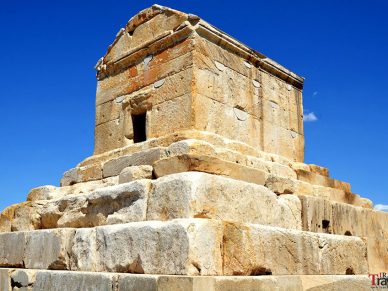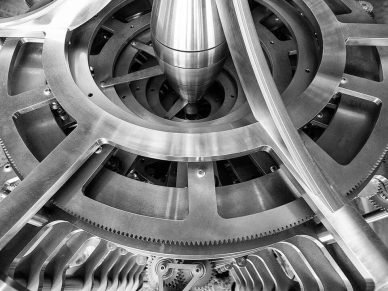The Clock of the Long Now is built to tick for 10,000 years, and to make us think about what it all means

How many seconds are there in 10,000 years? While there is an easily calculable answer – 3.1536e+11, give or take – the question is designed to make you stop and think about the enormity of time and take a long view of humanity. That’s the impetus behind the Clock of the Long Now, a 10,000-year clock that is the main project of The Long Now Foundation. The project, or at least the idea, is itself nearly 30 years old. Foundation co-founder Danny Hillis, an inventor and computer scientist, first laid out his desire to build the clock in a 1995 Wired essay.
“I want to build a clock that ticks once a year. The century hand advances once every one hundred years, and the cuckoo comes out on the millennium. I want the cuckoo to come out every millennium for the next 10,000 years,” he wrote. “Ten thousand years — the life span I hope for the clock — is about as long as the history of human technology.”
‘Whole Civilizations Will Rise and Fall’

Hillis originally expressed hope that he might see the cuckoo come out at the turn of the millennium, but it’s not up and running yet. The project itself has proved to be an exercise in patience and endurance. The clock won’t actually count the seconds, it seems, but measure time on a longer scale. It’s being built in the Sierra Diablo mountains in West Texas, on land owned by Hillis’ friend Jeff Bezos. In 2011, Bezos told Wired he was committing $42 million to the project. Figures have not been publicly updated since. In answering FAQs in February of this year, Hillis said only, “a lot more than I originally guessed!” in response to the question, “How much did this clock cost?”
Its creators are taking a longer view, not stressing too much about dollar amounts. “Over the lifetime of this clock, the United States won’t exist,” Bezos told Wired in 2011. “Whole civilizations will rise and fall. New systems of government will be invented. You can’t imagine the world — no one can — that we’re trying to get this clock to pass through.”
The remoteness of the clock’s location is by design. In the West Texas desert, it will experience arid conditions good for preservation, and its placement at the top of the mountain was chosen to provide shelter from the elements while also avoiding the kind of water incursion that comes from placing things underground. Functionally, the location also will make visiting the clock a pilgrimage of sorts in itself.
“The experience of visiting the clock is designed to unfold from the long journey to reach the entrance, through the final exit from darkness into the sunlight,” Hillis wrote this year, describing an arduous journey through narrow slots with sheer walls and a climb up a cliff. At the top of that cliff is another, unclimbable one with a small entrance at the bottom. Making their way through cave formations, visitors would encounter a small opening and a tunnel leading to a big metal door that serves as an airlock.
“Once you go inside, there’s another door behind it and you’ll discover that you can’t open the next door until you drop and let it close. So, there’s a moment of truth. You have to close the first door to open the second. That marks the transition. You are having to leave behind the ordinary world and enter into a different one. One that will stretch your sense of time,” Hillis wrote.
Designing a 10,000-Year Clock

As for the mechanics of the clock itself, designing a timepiece to last long beyond its creators and long beyond their civilizations is no mean feat. In an article for the BBC, Alexander Rose, longtime executive director of The Long Now Foundation described the process of choosing materials and location for the 10,000-year clock.
Many artifacts from the ancient world were preserved by being lost, he wrote, notably the Dead Sea Scrolls and the Antikythera mechanism, whose inner workings inspired the Clock of the Long Now’s design. Rose also noted that for future people stumbling upon the clock, a mechanical design leaves a much better archaeological record than an electronic one. To tick, the clock needs bearings, but even stainless-steel bearings will weld together or corrode well before 10,000 years have passed. So, the team chose industrial ceramic bearings designed for the vacuum of space that require no lubrication. In the clock chamber, the team has angled all underground surfaces away from the clock to redirect water to the bottom of the site.
Drawing lessons from other well-preserved ancient structures, Rose wondered if the builders should leave out easy-to-take valuables in the clock chamber as a way to distract any future intruders from destroying the clock. He noted that while grave robbers took gold and other precious items from tombs in Egypt’s Valley of the Kings, they left the wall murals intact.
“One of the more surprising strategies for longevity is actually to sacrifice some part of the object itself,” Rose wrote. “We see this in nature where a lizard’s tail can break off when attacked, allowing the lizard to escape alive.”
Hillis explained that the Clock of the Long Now, with a mechanism hundreds of feet tall “is powered by the temperature change from day to night, synchronized to the correct time by a beam of sunlight that shines deep into the mountain” around the summer solstice. While it is designed to keep accurate time for 10,000 years without maintenance, Hillis anticipates there will be continuous upgrades in the future as they were with the Egyptian Sphinx.
“It was designed to be continually improved upon, so in that sense it may never be finished,” he wrote.
The complex contains five room-sized chambers, one each for the first, 10th, 100th, 1,000th, and 10,000th anniversary of the clock’s timekeeping. In addition to carving out a space for celebration, they urge us to think differently about time and about how humanity might overcome its biggest challenges through a long process of collaboration through time.
“The 10,000-year time frame reminds us that our future is very big, so it’s worth striving to make it better,” Hillis wrote. “When you imagine a 10,000-year future, it is also easier to see how you can help that bend toward justice. You have more leverage with a longer view.”
Hillis envisions the clock will be fully operational in the next few years. For us all, time is already ticking.
















Leave a Reply